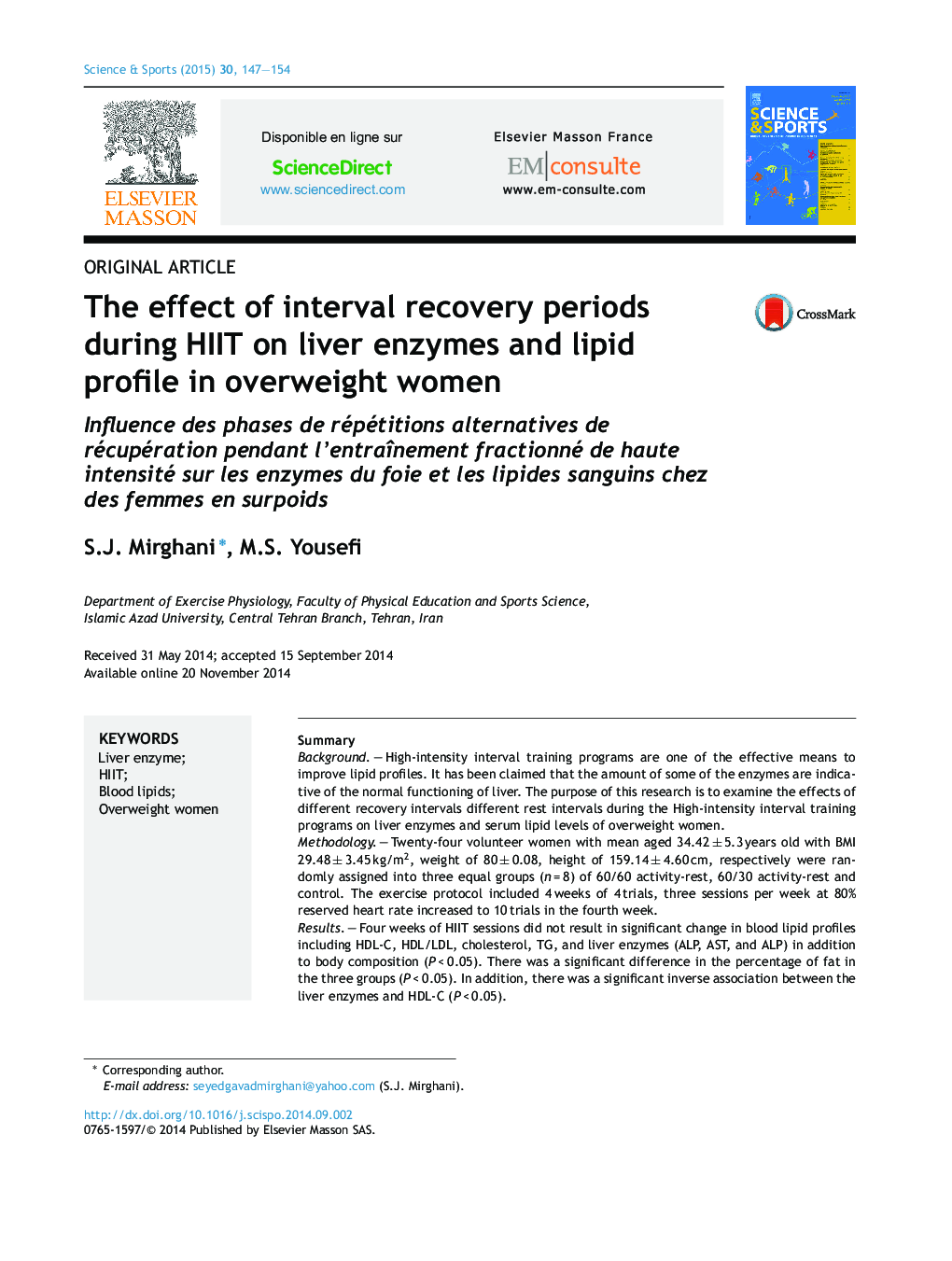| کد مقاله | کد نشریه | سال انتشار | مقاله انگلیسی | نسخه تمام متن |
|---|---|---|---|---|
| 4092652 | 1268267 | 2015 | 8 صفحه PDF | دانلود رایگان |

SummaryBackgroundHigh-intensity interval training programs are one of the effective means to improve lipid profiles. It has been claimed that the amount of some of the enzymes are indicative of the normal functioning of liver. The purpose of this research is to examine the effects of different recovery intervals different rest intervals during the High-intensity interval training programs on liver enzymes and serum lipid levels of overweight women.MethodologyTwenty-four volunteer women with mean aged 34.42 ± 5.3 years old with BMI 29.48 ± 3.45 kg/m2, weight of 80 ± 0.08, height of 159.14 ± 4.60 cm, respectively were randomly assigned into three equal groups (n = 8) of 60/60 activity-rest, 60/30 activity-rest and control. The exercise protocol included 4 weeks of 4 trials, three sessions per week at 80% reserved heart rate increased to 10 trials in the fourth week.ResultsFour weeks of HIIT sessions did not result in significant change in blood lipid profiles including HDL-C, HDL/LDL, cholesterol, TG, and liver enzymes (ALP, AST, and ALP) in addition to body composition (P < 0.05). There was a significant difference in the percentage of fat in the three groups (P < 0.05). In addition, there was a significant inverse association between the liver enzymes and HDL-C (P < 0.05).ConclusionBased on the result of this research, 4 weeks of HIIT activities result in no significant change in indices of blood lipids as well as liver enzymes. However, a considerable change was observed in the body fat percent that may be attributed to the exercise protocol.
RésuméIntroductionL’entraînement fractionné de haute intensité (HIIT) est considéré comme un moyen efficace d’amélioration des paramètres lipidiques du sang. On sait que certaines des enzymes du foie sont prises en compte comme indices les plus importants pour apprécier le fonctionnement d’un foie sain. Donc, l’objectif de cette recherche est d’étudier l’influence de différentes phases de récupération pendant l’entraînement fractionné à haute intensité sur les enzymes du foie et le profil lipidique sanguin chez les femmes en surpoids.MéthodologieVingt-quatre femmes (âge : 34,42 + 5,3 ans, IMC : 29,48 + 3,45, poids : 80 + 0,08, taille : 159,14 + 4,60), volontaires, ont été tirées au sort et divisées en trois groupes de 8 personnes). Le protocole d’exercice comprenait quatre semaines de quatre séances, dont trois par semaine à 80 % de la FC maximale pour atteindre 10 essais la quatrième semaine.RésultatsQuatre semaines d’entraînement fractionné à haute intensité n’a pas montré un changement significatif du profil lipidique sanguin (HDL-C, HDL/LDL, cholestérol et triglycérides) ainsi que pour les enzymes hépatiques ainsi que pour la composition corporelle (p < 5 %). Mais il y avait une différence significative dans le pourcentage de graisses pour ces trois groupes (p < 5 %) et, en plus, une relation inverse entre les enzymes hépatiques et le HDL-C (p < 5 %).ConclusionCette étude montre qu’un programme d’HIIT ne modifie pas le profil lipidique sanguin ainsi que le taux d’enzymes hépatiques. Cependant on observe un changement du pourcentage de graisses corporelles qui peut résulter du protocole d’exercice.
Journal: Science & Sports - Volume 30, Issue 3, June 2015, Pages 147–154